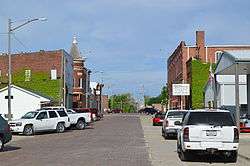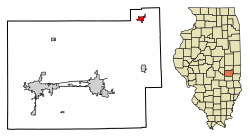Oakland, Illinois
Oakland is a city in Coles County, Illinois, United States. The population was 880 at the 2010 census.
Oakland | |
|---|---|
City | |
 Main Street | |
 Location of Oakland in Coles County, Illinois. | |
.svg.png) Location of Illinois in the United States | |
| Coordinates: 39°39′24″N 88°1′31″W | |
| Country | |
| State | |
| County | Coles |
| Township | East Oakland |
| Area | |
| • Total | 0.82 sq mi (2.12 km2) |
| • Land | 0.78 sq mi (2.02 km2) |
| • Water | 0.04 sq mi (0.09 km2) |
| Elevation | 659 ft (201 m) |
| Population (2010) | |
| • Total | 880 |
| • Estimate (2019)[2] | 854 |
| • Density | 1,092.07/sq mi (421.77/km2) |
| Time zone | UTC-6 (CST) |
| • Summer (DST) | UTC-5 (CDT) |
| ZIP Code(s) | 61943 |
| Area code(s) | 217 |
| FIPS code | 17-54781 |
| Wikimedia Commons | Oakland, Illinois |
History
Oakland, formerly known as Independence, was platted in 1833.
Pioneer doctor and abolitionist Dr. Hiram Rutherford moved to Oakland in 1840 to start his practice in the young town. He became a prominent citizen. Rutherford is most widely known for his involvement in the 1847 Matson Trial, which involved his friend Abraham Lincoln. A Kentucky slave owner, Gen. Robert Matson, annually brought slaves to work on his land near Oakland. One year, a family of slaves ran away from the farm and took refuge with Dr. Rutherford and Gideon Ashmore. Matson sued the men for harboring slaves; Rutherford and Ashmore countered that the slaves could not legally be held in a free state. Rutherford attempted to have Lincoln represent him in the case, but Lincoln had already agreed to represent the slave owner. Matson, represented by Lincoln, lost the case in Coles County court.[3]
Rutherford's home and office, as well as other historic sites, are maintained and available for tours.

Geography
Oakland is located at 39°39′24″N 88°01′31″W.[4]
According to the 2010 census, Oakland has a total area of 0.873 square miles (2.26 km2), of which 0.83 square miles (2.15 km2) (or 95.07%) is land and 0.043 square miles (0.11 km2) (or 4.93%) is water.[5]
Demographics
| Historical population | |||
|---|---|---|---|
| Census | Pop. | %± | |
| 1880 | 727 | — | |
| 1890 | 995 | 36.9% | |
| 1900 | 1,198 | 20.4% | |
| 1910 | 1,159 | −3.3% | |
| 1920 | 1,210 | 4.4% | |
| 1930 | 1,036 | −14.4% | |
| 1940 | 1,131 | 9.2% | |
| 1950 | 980 | −13.4% | |
| 1960 | 939 | −4.2% | |
| 1970 | 1,012 | 7.8% | |
| 1980 | 1,035 | 2.3% | |
| 1990 | 996 | −3.8% | |
| 2000 | 996 | 0.0% | |
| 2010 | 880 | −11.6% | |
| Est. 2019 | 854 | [2] | −3.0% |
| U.S. Decennial Census[6] | |||
As of the census[7] of 2000, there were 996 people, 416 households, and 294 families residing in the city. The population density was 1,215.8 people per square mile (469.0/km2). There were 437 housing units at an average density of 533.4 per square mile (205.8/km2). The racial makeup of the city was 99.10% White, 0.20% African American, 0.10% Native American, and 0.60% from two or more races. Hispanic or Latino of any race were 0.90% of the population.
There were 416 households out of which 31.7% had children under the age of 18 living with them, 55.0% were married couples living together, 12.5% had a female householder with no husband present, and 29.1% were non-families. 26.2% of all households were made up of individuals and 14.9% had someone living alone who was 65 years of age or older. The average household size was 2.39 and the average family size was 2.86.
In the city, the population was spread out with 26.1% under the age of 18, 7.5% from 18 to 24, 24.7% from 25 to 44, 24.8% from 45 to 64, and 16.9% who were 65 years of age or older. The median age was 40 years. For every 100 females, there were 94.9 males. For every 100 females age 18 and over, there were 84.0 males.
The median income for a household in the city was $34,038, and the median income for a family was $38,167. Males had a median income of $29,342 versus $20,577 for females. The per capita income for the city was $15,964. About 8.8% of families and 10.8% of the population were below the poverty line, including 20.2% of those under age 18 and 7.6% of those age 65 or over.
Notable people
- Robert Matson, was a slaveowner who was involved in the 1847 Matson Slave Trial and his defense attorney was Abraham Lincoln.
- Stanton C. Pemberton, Businessman and Illinois state senator
- Dr. Hiram Rutherford, was a doctor and abolitionist who was involved in the 1847 Matson Slave Trial along with Abraham Lincoln.
References
- "2019 U.S. Gazetteer Files". United States Census Bureau. Retrieved July 14, 2020.
- "Population and Housing Unit Estimates". United States Census Bureau. May 24, 2020. Retrieved May 27, 2020.
- "Dr Rutherford reference". Archived from the original on 2007-09-30. Retrieved 2020-04-22.
- "US Gazetteer files: 2010, 2000, and 1990". United States Census Bureau. 2011-02-12. Retrieved 2011-04-23.
- "G001 - Geographic Identifiers - 2010 Census Summary File 1". United States Census Bureau. Archived from the original on 2020-02-13. Retrieved 2015-12-27.
- "Census of Population and Housing". Census.gov. Retrieved June 4, 2015.
- "U.S. Census website". United States Census Bureau. Retrieved 2008-01-31.